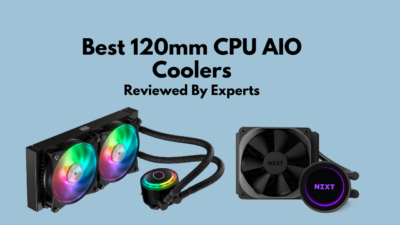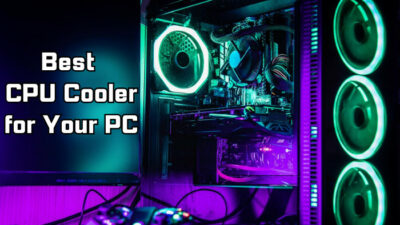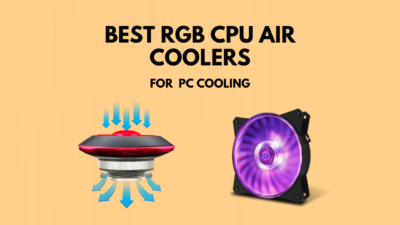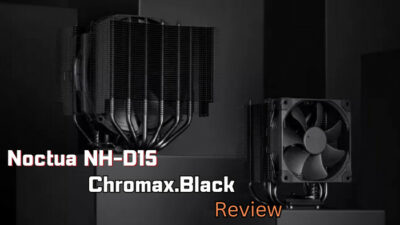Each year the CPU gets smaller while packing millions of transistors on a single chip, making it faster and smarter than ever before. This produces so much heat that a typical air cooler cannot handle.
This is where the liquid cooling system comes to your rescue. It effectively keeps the CPU temperature at the optimal level.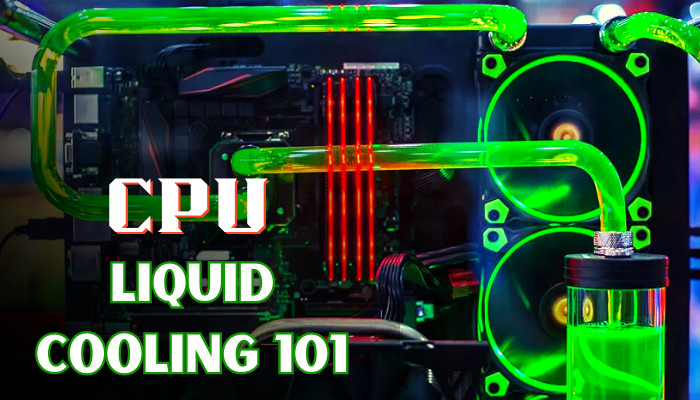
But what are liquid coolers, how do they lower the processor temperature and are they really safe? You’ll find out these and a whole lot more in this article.
Let’s begin!
What is Water Cooling?
Liquid or water cooling is used to reduce the temperature of CPUs and, occasionally, GPUs. In liquid cooling systems, a liquid, typically water, is circulated through pipes. The water absorbs heat from the components and releases it through a radiator.
Unlike air cooling, which relies on air as the cooling medium, water cooling utilizes water because it conducts heat approximately 30 times more rapidly than air.
Aside from its superior heat conductivity, a water-cooling system lets PC parts function faster while maintaining low system noise.
As electronic devices operate, they generate heat. With advancements in computer technology, components become faster while they get smaller, resulting in increased heat concentration in smaller areas. In the conventional approach, air cooling has been the most common method to disperse computer heat by utilizing heat sinks, heat pipes, and fans.
However, computer systems with powerful components produce higher temperatures than air cooling can effectively handle. It is particularly common in overclocked systems, configurations with multiple GPUs, or high-density setups.
For these powerful systems, liquid cooling cpu can efficiently expel heat faster, enabling these systems to function at higher speeds while remaining cooler and quieter.
Water cooling is primarily used in personal and gaming computers. It lets overclocked CPUs and GPUs run smoothly and maintains optimal component temperatures. It extends the longevity of the parts and enables the use of powerful components in compact form factors.
What are the Components Used in Liquid-Cooled Systems?
Water cooling systems comprise several components: a pump, water block, pipes, radiator, and an optional reservoir. The pump primarily aims to circulate the liquid throughout the entire system.
Inside the system, the liquid flows through the water block, which is connected to the CPU or GPU, absorbing heat from these components. It is also possible to incorporate multiple water blocks in a single system.
Afterward, the heated water travels to the radiator, where fans blow cold air over the cooling pipes, effectively dissipating the heat. Flexible or rigid pipes and tubing are used to move the water within the system.
for your convenience, we’ve tested and compiled the lists of the best water-cooling kits and water-cooling pumps for your gaming PC.
You can also use a reservoir to enhance thermal mass and increase the water capacity. Sometimes, we mix biocide with water to prevent the growth of algae or bacteria.
How Does Liquid CPU Cooling Work?
CPU Liquid cooling systems can be categorized into two primary types: Open Loop & Closed Loop. Open loop systems require users to create and assemble the system using individual components. Conversely, closed-loops, often called AIO, are pre-arranged units you can buy.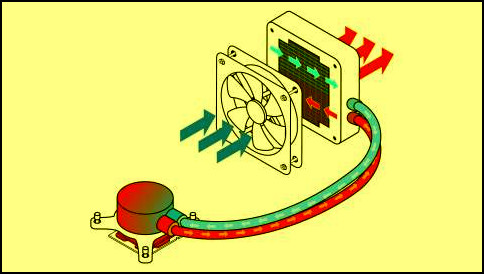
Below I’ve explained how different types of liquid coolers work:
AIO Systems
The AIO (All-In-One) system involves the connection of a baseplate to the Integrated Heat Spreader (IHS) using a layer of thermal paste.
The IHS plays a crucial role in enhancing heat transfer efficiency. The metal face of the backplate forms an integral section of the water block, specifically designed to contain coolant.
As the coolant flows through the water block, it absorbs heat from the baseplate. It continues its path through the system, moving upward using one of two tubes leading to a radiator.
When passing through the radiator, the water releases heat to the liquid cooler with the help of a heat sink. The radiator assists in cooling by exposing the liquid to air, while an attached fan expels the heat away from the cooler.
The cooled liquid again circulates through the system to repeat the process. The heated liquid exits to a radiator positioned at the back of the case, dissipating the heat outside.
Custom Cooling Loops
When it comes to creating custom cooling loops, there is a higher level of complexity involved compared to using an AIO cooling system. This complication arises from installing each cooling system component individually.
In addition to the essential components like radiators, tubes, and fans, custom cooling loops require additional elements. These include water blocks for every component in the loop, a reservoir to keep the heat carrier liquid, and a pump to facilitate the liquid circulation throughout the radiator, water blocks, and reservoir.
In such configurations, the server is typically kept within a rack. The tubes attached to the radiator are responsible for transporting the hot liquid out of the system and into a reservoir. At the same time, separate tubes bring the filtered and cool liquid into the system.
What is the Best Liquid for CPU Cooling?
Water is an excellent option for liquid cooling due to its remarkable thermal conductivity and heat capacity. Moreover, it seamlessly integrates with copper, which is among the finest materials for facilitating efficient heat transfer along your fluid pathway.
A liquid cooling loop can be easily set up using just distilled water and a biocidal. These two components are sufficient for the pump to circulate the liquid, transferring heat from the blocks to the radiator.
The biocide protects all the parts from corrosion and stops bacteria from growing. Also, it doesn’t affect the color of the water, resulting in a transparent liquid.
By using biocide and distilled water, your loop is now complete and will function well for approximately 6 to 12 months before you need to flush and refill.
If you want to enhance the appearance of your water cooling loop with some color, use a dye of your preference. It will create vibrant hues and improve the visual aesthetics inside your PC case.
Here’s the list of the best coolants you can buy right now!
What are the Advantages of Water Cooling for the CPU?
Liquid cooling for CPUs offers enhanced performance and user experience. It dissipates heat, keeping the CPU cool during demanding tasks for improved stability and longevity. Lower temperatures prevent throttling and enable higher clock speeds.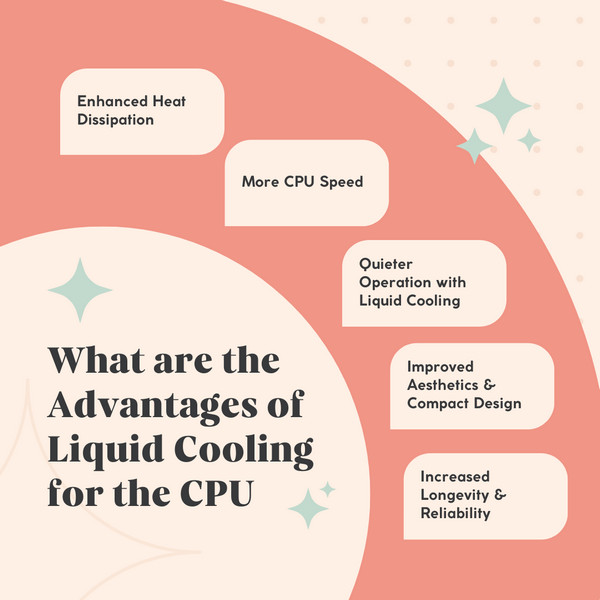
Below I’ve provided the advantages of liquid cooling for the CPU:
Enhanced Heat Dissipation
Liquid cooling has emerged as a more efficient alternative to traditional air cooling technology when it comes to dissipating heat from computer components. By utilizing liquid coolant, you can dissipate heat more effectively from the CPU.
More CPU Speed
Liquid cooling plays a vital role in allowing processors to operate at higher speeds while staying within the temperature limit set by the manufacturer.
This improved cooling efficiency has made water cooling a popular choice among advanced CPU overclockers who aim to push their processors to the limit. In some cases, these individuals have been able to double processor speeds by implementing intricate liquid-cooling setups.
Quieter Operation with Liquid Cooling
Another advantage of liquid cooling is its ability to reduce noise levels during operation. Traditional heatsink-and-fan combinations often generate significant noise as the fans work tirelessly to circulate large volumes of air.
High-performance CPUs, in particular, may require fan speeds exceeding 5000 rpm, and overclocking demands even greater airflow.
Liquid cooling minimizes the engine noise caused by these fans, resulting in a quieter computing experience.
Improved Aesthetics & Compact Design
Liquid cooling systems often come with sleek, customizable designs that enhance the visual appeal of a computer build. They consist of compact components such as CPU water blocks, radiators, and tubing, which can be arranged neatly within the case.
This can help create a clean and organized look, especially in systems with transparent panels or custom lighting.
Increased Longevity & Reliability
Water cooling systems can contribute to the durability and stability of the CPU. By keeping the temperatures lower and more stable, they reduce thermal stress on the processor, potentially extending its lifespan.
Also, liquid cooling eliminates the risk of dust accumulation on heat sinks and fans which can obstruct airflow and negatively impact cooling efficiency over time.
What are the Disadvantages of Liquid Cooling for CPU?
Although water coolers offer enhanced thermal management for CPUs, they have a few drawbacks. They require additional investment & maintenance with regular check-ups, cleaning, and monitoring. Also, there’s the risk of water leaks that can permanently damage your PC.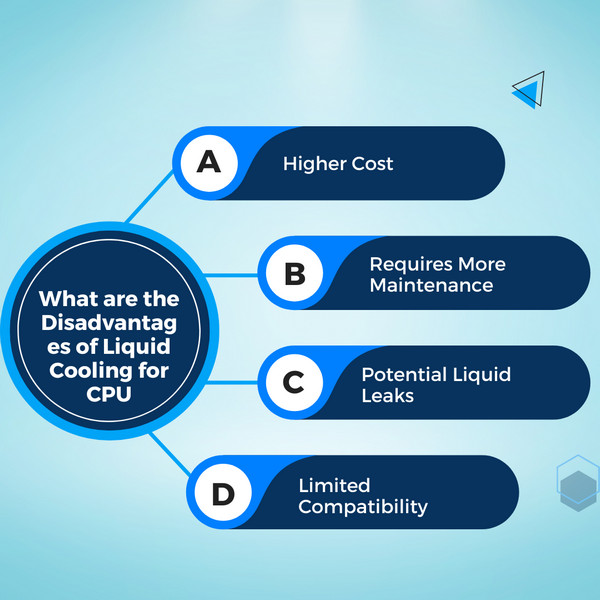
Here are the disadvantages of liquid cooling for CPU:
Higher Cost
Water cooling systems are more expensive than air cooling solutions. They incorporate extra elements like a pump, radiator, reservoir, and tubing, which can increase the overall expenses of your setup. Additionally, the cost can further escalate due to the necessary maintenance and potential repairs.
Requires More Maintenance
Although liquid coolers can provide effective heat dissipation, they require occasional maintenance to ensure optimal performance. Over time, the coolant will evaporate and accumulate debris, affecting cooling efficiency.
You must check coolant levels, clean or replace filters and perform system flushes, which can be time-consuming.
Potential Liquid Leaks
In the event of a leak with liquid cooling systems, it can destroy vital components like the CPU, motherboard, or graphics card. Careful installation and regular maintenance are crucial to minimize the risk of leaks.
Limited Compatibility
Not all computer cases and CPU coolers are designed to accommodate liquid cooling systems. The size and placement of radiators and fans can pose challenges in certain cases, restricting the options for liquid cooling.
How to Maintain a Liquid-Cooled PC
Maintaining a liquid cooling system can often feel like a daunting task, especially when considering the potential risks associated with water near your PC. However, with the guidelines I’ve provided here, you can ensure that your system remains in optimal condition.
If you have Closed Loop Systems, generally you do not require user maintenance. These systems are designed to be serviced solely by the providers, and I’d advise you to refer to the manufacturer’s manual before trying any form of maintenance.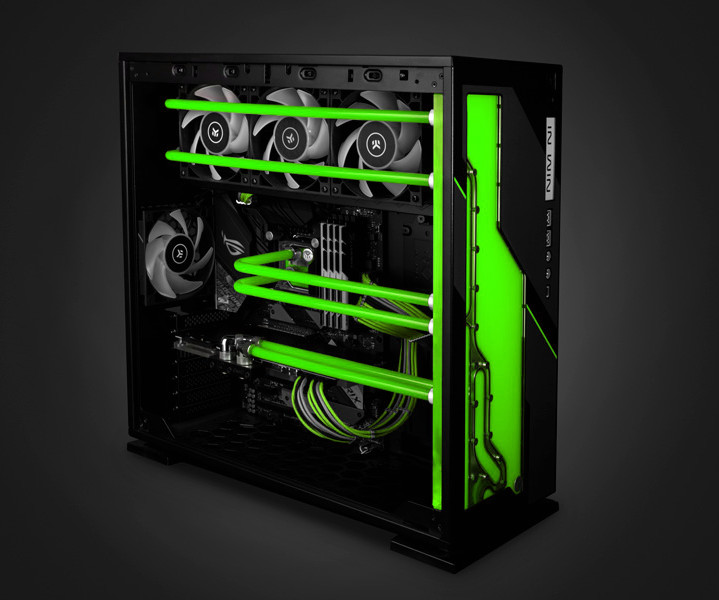
For those with an Open Loop System, it is important to familiarize yourself with the essential components of a liquid cooling system, namely the radiator, fan, coolant, water block, and water pump. Also, you must know how to tell if the CPU liquid cooler is working.
To begin the maintenance process of your liquid-cooled system, let’s start with the radiator. The radiator’s fins play a vital role in distributing coolant throughout your PC, effectively keeping your components cool.
However, dust accumulation on the blades is common due to the constant rotation of the fans. To resolve the issue, use either compressed air or a soft paintbrush to remove any dust build-up.
Next, comes the water pump, the core component responsible for circulating the distilled water throughout the cooling loop and maintaining the desired temperature of your components.
Though the pump generally does not require regular maintenance, perform a coolant flush using distilled water at least once a year. This process helps keep the loop clean and ensures its smooth operation. During the coolant flush, you can also clean the water block. To minimize oxidation and dust accumulation, disassemble the water block and soak it in a dissolvable solution.
Do a system flush at least once a year. This process involves draining the existing coolant and changing it with a new coolant. To minimize the risk of corrosion to your computer parts, I’d highly recommend you use distilled water mixed with biocide, and inhibitors during this process.
Now you are equipped with everything you need to know to effectively maintain your water-cooling PC.
How Long Does Liquid Cooling Last in a CPU?
A high-level all-in-one (AIO) water cooling solution delivers reliable performance for around 3 to 6 years on average. However, when it comes to custom liquid cooling solutions, their lifespan tends to be shorter, usually ranging from 1 to 3 years if left without any maintenance.
However, with proper care, including regular cleaning and flushing, a custom setup can match and even surpass the longevity of an AIO cooler.
Unlike AIO coolers, which often require minimal user intervention, custom liquid cooling setups demand more manual maintenance to ensure their longevity. You cannot just set it up and then forget.
By dedicating your time and effort to frequently clean and flush the system, you can effectively prevent the accumulation of debris, dust, or sediment that may hinder its efficiency and potentially lead to hardware issues.
FAQs
Is liquid cooling good for the CPU?
Liquid cooling is good for the CPU as it operates with greater efficiency by effectively dispersing heat over a larger surface area, which is the radiator.
What is CPU cooling liquid made of?
CPU cooling liquid is made of deionized water or a non-conductive & non-capacitive fluid. Avoid using tap water due to the presence of ions, which can potentially cause corrosion in the water blocks.
Is liquid cooling better than thermal paste?
Liquid cooling is better than thermal paste because its thermal conductivity is greater, with values ranging from 60 to 80 W/mK, and a typical thermal paste’s conductivity is from 5 to 15 W/mK. Liquid metal facilitates a faster and more efficient heat transfer process, leading to reduced CPU temperatures.
Final Thoughts
CPU liquid cooling offers a highly efficient and effective solution for managing heat dissipation in modern computer systems.
Due to its exceptional capacity for delivering enhanced cooling efficiency, decreased noise, and increased potential for overclocking, water cooling has become popular among gamers and content creators.
In this article, you’ll know everything you need to know about liquid coolers for CPUs, from how they work to how to maintain them. Comment below if you have further questions, and we’ll get back to you.

